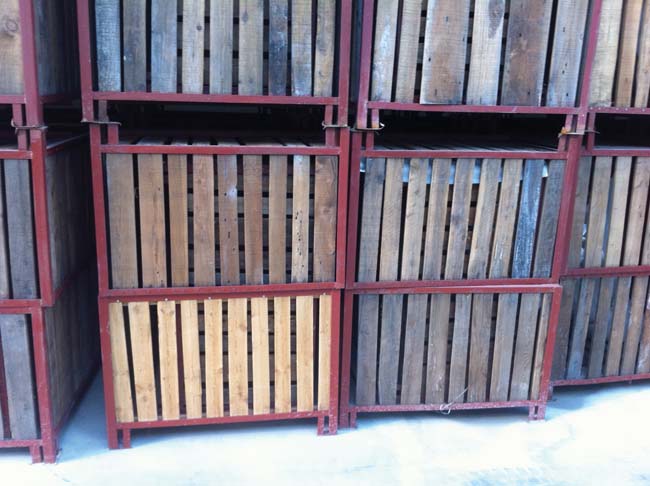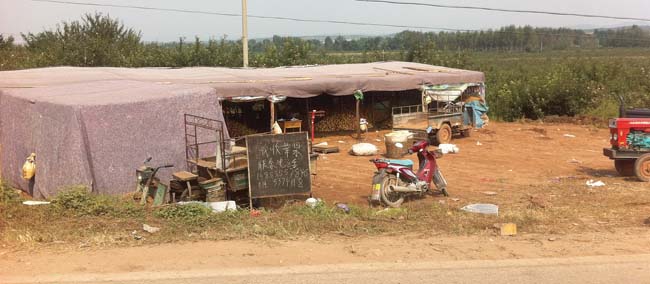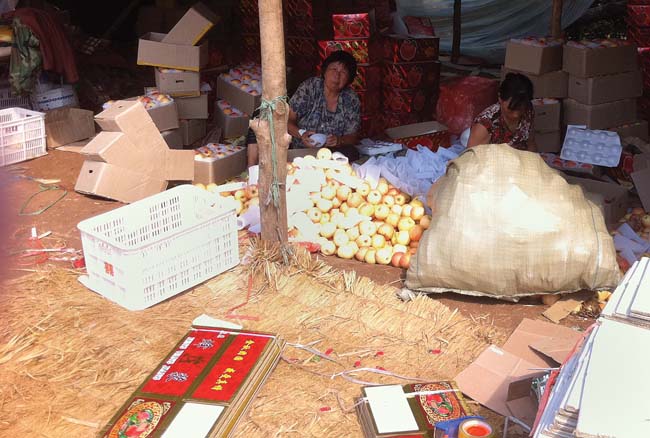Chinese packers have been unable to convince growers to update orchards to improve yields and color. Shandong growers are unwilling to lose production in the short term in order to improve future production.
Although China is the world’s top apple producer in terms of volume, its apple producers have a limited ability to meet the demands of high-value export markets, such as Europe and Canada.
For the same reason, if the U.S. market opens to imports from China, volumes will probably be limited, Todd Fryhover, president of the Washington Apple Commission, concluded after touring orchards and packing facilities in China’s major apple-growing region, Shandong Province, during harvest this fall. Fryhover and Frank Davis, chair of the commission’s board, took the opportunity to look at China’s apple industry before joining a trade mission in China with Washington State’s Governor Christine Gregoire.
Fryhover estimates the apple-growing area in Shandong to be four or five times the size of Washington’s Columbia Basin. “It’s very difficult to describe the vastness of the Shandong growing region,” he reported. “As far as the eye could see, apple orchards lined the valley and hillsides.”
The climate in Shandong is similar to New York’s. Orchards lack irrigation and frost protection. About 90 percent of the apples are Fuji. All apples are bagged on the trees to protect them from insects. Almost all of the orchards were very dense, which limited light penetration. There was no way to drive a tractor between the trees. Yields averaged the equivalent of 15 bins per acre.
Although packers have tried to convince growers to take out every other tree to improve yields and fruit color, growers are focused on the near term and are unwilling to lose even one year’s production in the hopes of increased future production. This single issue could limit China’s future competitiveness, Fryhover believes.
Growers are mostly aged over 60 and have small orchards, often less than an acre. It was common to see several crops planted in and around the fruit trees. Labor costs range from $0.30 to $0.50 an hour. This low cost is the reason for a lack of willingness to invest in machinery, both at the orchard and packing level.
Pickers harvest into plastic bushel bins or large wooden baskets and carry them to the end of the rows for pick up by tuk-tuks. The apples are then consolidated for delivery to the warehouse.
Although there is no lack of labor, there is concern about young people moving to cities in search of better opportunities, Fryhover learned. However, he was told it’s likely that the younger generation will return to orchards because of limited employment opportunities in the larger cities.
Packing
Fryhover and Davis visited a modern packing facility in Qixia, which is set up similar to most Washington packers. The company owns no orchards and buys fruit from growers within a 125-mile radius.
Growers pick into 15-kilo (33-pound) plastic boxes provided by the packer and bring the fruit to the packing house for inspection. The company requires growers to size and grade the apples before delivery. After inspection for size and grade, the company offers a cash price for the load of apples. Growers can either accept or go elsewhere. Because growers are paid immediately, the company has upfront costs of between $2 and $3 million for the season. (Costs are given in U.S. dollars.)
It’s a common practice for growers to bribe inspectors for an improved grade, since this determines the value of their crop. The packing company keeps its inspectors inside curtained areas to avoid bribery, and the process is diligently supervised. It would not be uncommon to see growers put money within samples in an attempt to bribe the inspectors, Fryhover was told.
After delivery and purchase, the fruit is put into wooden bins with permeable liners and treated with SmartFresh (1-methylcyclopropene) in storage to extend the marketing season until May.
The packing line has a four-lane sizer with water dump but no waxing capabilities. The company has six controlled-atmosphere storage rooms holding 1,000 to 1,200 bins, but they were used as regular storage. Packing costs were estimated at $0.15 per carton.
Exports
The company packs up to 400,000 cartons annually, of which 90 percent are exported. Sales are handled in house. India is the largest market and generates the highest returns, with prices as high as $32 a carton for premium Fuji apples.
The most difficult markets for the Chinese to access are the European Union and Canada, which is why the company focuses on India. Asked if the company would be interested in shipping to the United States, if allowed, the managers said they would, but only if prices were high enough so it made economic sense.
Fryhover and Davis then visited another packer in Qixia, whose facility is about four times the size of the first one. Annual production is around 1.2 million bushels, of which 90 percent are exported.
The plant has individual packing rooms and different handling practices for the local, Middle East, Canadian, and European markets. The company’s primary markets are Europe and the Middle East.
The company produces three containers per day for the Middle East. The apples are simply hand-packed into high-graphic bushel cartons after sizing, with no washing or wax and no oversight for grading or phytosanitary issues.
About 100 containers go annually to Canada. For this market, it takes 30 people almost two weeks to package one container because of the stringent protocol. Workers clean the calyx and stem end of each apple, but since labor is cheap, the additional labor does not seem to be a concern.
A new packing line, with washing and sizing capabilities, was being installed to handle fruit for Europe. All the equipment was of stainless steel and made in China.
The owners were enthusiastic about new business and told Fryhover they would export to the United States if allowed, though they were concerned about what the requirements might be.
The company houses and feeds about 200 workers year round and 480 during harvest at its own expense.
Alternative packing
Some fruit is packed in tents at the orchard. Apples are placed on a tarp on the ground and hand-packed into Styrofoam socks and then into high-graphic cartons. This product goes directly to the domestic market. Fryhover said the tent packers take the opportunity to fulfill immediate domestic demand at harvest and are not in business season long.
Fryhover said the Chinese fruit industry is not a unified entity. Growers and packers work independently with no industry groups to represent them. Growers are out to maximize profitability in any way possible, and the packers, who assume all the financial risk, look for the highest return. It’s unlikely, therefore, that they would want to sell fruit in the United States at low prices if they have other opportunities. “It’s capitalism in its true form,” Fryhover commented.
He said the trip provided baseline information on the changing Chinese industry and a more thorough research project is warranted. Shandong produces about 27 percent of China’s apples.
The second-largest apple-growing area is Shaanxi, which Fryhover and Davis did not visit. Shaanxi has growing conditions similar to Washington’s.

Orchard rows are planted too closely for tractors. Apples are often picked into baskets, which are carried to the ends of the rows for transportation by tuk-tuk to the packing house.

Apples are delivered in baskets or plastic bushel boxes to the packing house, where they are transferred into bins.

Chinese packers have been unable to convince growers to update orchards to improve yields and color. Shandong growers are unwilling to lose production in the short term in order to improve future production.

Fruit for China’s domestic market is sometimes packed in a makeshift tent set up at the orchard at harvest.

Women pack apples in a tent at the orchard. The apples are first put in socks and then packed in high-graphic cartons to be sold directly on the domestic market.

Leave A Comment